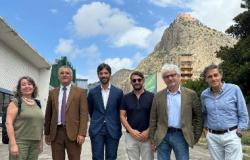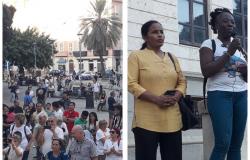Lamezia Terme – Unexpected glimpses, historical jewels, unknown places yet just a stone’s throw from us, right in the city centre: they have been rediscovered by the Icica association, a cultural reality with the aim of bringing together young people and valorising the territory, which organized an experience of “Urban Trekking between past and future” open to the public and completely free, taking visitors for a walk through the oldest areas of old Nicastro, under the guidance of the Lametina art historian Teresa Gaetano, of Don Vittorio Dattilo, historical memory of the place , of the president of the association Paolo Caserta and of the councilor for urban planning, engineer Stella, who illustrated during the journey the new interventions that will be made to benefit the habitability of these areas thanks to the Pnrr funds and the Pinqua plan.
Starting from via Garibaldi, the walk crossed the districts of Timpone, San Teodoro, Santa Lucia, the Piedichiusa park, to reach the abandoned green space in the upper part of the Torre district, once home to the Clarisse garden and then used in the time to various functions, which the association has been trying to make usable for the city again for about a year, with the support of the administration, as it is the only large park present in the historic center.
An ancient history that of this centre, retraced by Teresa Gaetano in front of the imposing statue of Federico II, the work of the artist Maurizio Carnevale. “The first settlement in the area seems to have been that of the Enotra population of the Lametinoi, settled near the river Lametus – Latin name of the current Amato”, explains Dr. Gaetano, “The birth of Neo Kastrum (or in Greek Nio Kastron) – name which was attributed to newly founded Byzantine cities – dates back to the 8th/9th century AD, and occurs subsequently in the presence of a settlement of more ancient foundation, which must have been in the area of Sant’Eufemia Vetere”.

Following the birth of the Castle, which flourished in the Norman period, and passed from the jurisdiction of the Benedictine Abbot of the Abbey of Sant’Eufemia Vetere to direct royal control under Frederick II, who made it an important center into which the tributes of his kingdom flowed . After a mention of the ancient Norman cathedral of San Pietro in Vinculis, today buried under the small church of the Crucifix, and the earthquake of 1638 which almost entirely destroyed the city, resulting in the reconstruction of many churches in seventeenth-century baroque style, we reach the small church of Timpone , dedicated to Sant’Agazio, a Byzantine saint, and built by a local lord, Antonio Vicino, to avoid that the dead, during the floods that isolated the neighborhood, would not remain for days without funerals and burials, being able to be transported to the Veterana church.

Don Vittorio Dattilo’s contribution is important in reconstructing the religious, pastoral and devotional history of the churches of Timpone and Santa Lucia, the latter his parish since 1971, when “religion was still mixed with superstitions, popular beliefs, folklore” and there was a strong commitment to “integrated pastoral care, which acted on all levels of common living, through neighborhood committees, consumer and work support cooperatives, welcoming vulnerable people, participation in civil battles, such as the objection of conscience”, and the decision to replace the classic images of the Saint, objects of superstition, with images that carried messages of strong social and spiritual impact on the back. Another mention of the historic buildings in the area, that of the Lanzo family, now abandoned, and that of the Statti family, and the once fervent economic life of the neighborhood, where, in addition to the mills, there were four oil mills.

The intervention of councilor Stella on the Pnrr funds destined for the historic center of the city was important and the subject of debate, “also assigned among the top ten Italian cities of the Pinqua funding (National Plan for the Quality of Living) which will be destined to redevelop the real estate assets of these areas, improving their livability, and making possible, in some cases of historical-artistic interest, conservative restoration, in others the contribution according to appropriate rules of modifications and interventions that allow their use in modern times, in others again, where recovery is not possible, reconstruction from scratch”. A way to avoid the depopulation of these splendid ancient neighbourhoods, which we hope will be a driving force for tourism and craftsmanship, and be intended for housing for young couples and single-parent families who apply for new accommodation.
The boys of Icica hope so, with the associates Trovato, Montesanti, Rialti, Di Cello, Rocca, the vice-president Reale, who have, according to the president Caserta, new urban trekking initiatives in the pipeline also in Sambiase and Sant’Eufemia, and of film clubs for the summer in the green space that they are lovingly bringing back to life.
Giulia De Sensi


© ALL RIGHTS RESERVED












